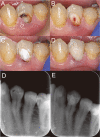Super Minimally Invasive Pulp Therapy for Severe Pulpitis: A Report of Two Cases
- PMID: 37637564
- PMCID: PMC10457134
- DOI: 10.7759/cureus.42505
Super Minimally Invasive Pulp Therapy for Severe Pulpitis: A Report of Two Cases
Abstract
In regions where preventive dentistry is widespread, tooth loss due to root fracture occurs approximately 10 times more frequently than that due to caries and periodontal disease. Root fracture is most likely to occur in non-vital teeth, where the dental pulp has been removed, often through a procedure known as pulpectomy. However, super minimally invasive pulp (SMIP) therapy has recently been reported as a novel treatment approach for pulpitis of any degree. In this study, SMIP therapy was performed to preserve the vitality of teeth in two patients with severe pulpitis. Case one involved a 35-year-old man with a history of hypertension who presented with intense spontaneous pain in tooth #34. The pain was particularly severe while sleeping at night and on exposure to cold water or heat, but it was absent on percussion. Following the detection of cervical caries and severe pulp exposure, SMIP therapy was administered, and the tooth was subsequently restored using glass ionomer cement. Case two involved an 18-year-old woman with no significant medical history who had deep caries in tooth #46. She experienced mild tooth pain when exposed to cold water, and examination revealed pulp exposure. We applied mineral trioxide aggregate over the dental pulp and restored the tooth using composite resin. The vitality of both teeth was maintained at the three-month follow-up. To our knowledge, this is the first report of SMIP therapy for teeth with severe pulpitis. SMIP therapy is an innovative treatment that may cause a paradigm shift from conventional dental treatment.
Keywords: caries; dental pulp; periodontal disease; preventive dentistry; pulpectomy; root fracture; super minimally invasive pulp therapy; teeth vitality; tooth loss.
Copyright © 2023, Kojima et al.
Conflict of interest statement
The authors have declared that no competing interests exist.
Figures



Similar articles
-
Maintaining Tooth Vitality With Super Minimally Invasive Pulp Therapy.Cureus. 2022 Sep 28;14(9):e29712. doi: 10.7759/cureus.29712. eCollection 2022 Sep. Cureus. 2022. PMID: 36321001 Free PMC article.
-
Vital Pulp Therapy in Permanent Teeth with Irreversible Pulpitis Caused by Caries: A Prospective Cohort Study.J Pers Med. 2021 Nov 1;11(11):1125. doi: 10.3390/jpm11111125. J Pers Med. 2021. PMID: 34834477 Free PMC article.
-
A prospective clinical study investigating the effectiveness of partial pulpotomy after relating preoperative symptoms to a new and established classification of pulpitis.Int Endod J. 2021 Dec;54(12):2156-2172. doi: 10.1111/iej.13629. Epub 2021 Sep 26. Int Endod J. 2021. PMID: 34490637
-
[Definitive injuries to the teeth. Lesions of hard tissue and pulp].Rev Belge Med Dent (1984). 1998;53(2):29-91. Rev Belge Med Dent (1984). 1998. PMID: 9951346 Review. French.
-
Management of deep caries and the exposed pulp.Int Endod J. 2019 Jul;52(7):949-973. doi: 10.1111/iej.13128. Epub 2019 May 13. Int Endod J. 2019. PMID: 30985944 Review.
References
-
- Dental status and compression of life expectancy with disability. Matsuyama Y, Aida J, Watt RG, et al. J Dent Res. 2017;96:1006–1013. - PubMed
-
- Tooth loss as a predictor of shortened longevity: exploring the hypothesis. Friedman PK, Lamster IB. Periodontol 2000. 2016;72:142–152. - PubMed
-
- Why do some people lose teeth across their lifespan whereas others retain a functional dentition into very old age? Thorstensson H, Johansson B. Gerodontology. 2010;27:19–25. - PubMed
-
- The natural history of periodontal disease in man. Tooth mortality rates before 40 years of age. Löe H, Anerud A, Boysen H, Smith M. J Periodontal Res. 1978;13:563–572. - PubMed
-
- Clinical studies concerning re-restoration of teeth. Elderton RJ. Adv Dent Res. 1990;4:4–9. - PubMed
Publication types
LinkOut - more resources
Full Text Sources
